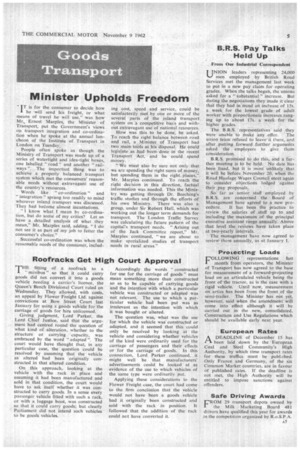Roofracks Get High Court Approval
Page 7

If you've noticed an error in this article please click here to report it so we can fix it.
THE fitting of a roofrack to a
" minibus " so that it could carry goods did not convert it into a goods vehicle needing a carrier's licence. the Queen's Bench Divisional Court ruled on Wednesday. They allowed, with costs, an appeal by Flower Freight Ltd. against convictions at Bow Street Court last January for using a goods vehicle for the carriage of goods for hire unlicensed.
Giving judgment, Lord Parker, the Lord Chief Justice, said that the argument had centred round the question of what kind of alteration, whether to the structure or carrying capacity, was embraced by the word "adapted ". The court would have thought that, in any particular case, the question could be resolved by assuming that the• vehicle as altered had been originally constructed in that altered condition.
On this approach,. looking at the vehicle with the rack in place and assuming it had been manufactured and sold in that condition, the court would have to ask itself whether it was constructed to carry goods. In a sense every passenger vehicle fitted with such a rack, or with a luggage boot, was constructed so that it could carry goods; but clearly Parliament did not intend such vehicles to be goods vehicles.
Accordingly the words "constructed for use for the carriage of goods" must mean something more than constructed so as to be capable of carrying goods and the intention with which a particular vehicle was constructed or adapted was not relevant. The use to which a particular vehicle had been 'put was as irrelevant as the intention with which it was bought or altered.
The question was, what was the use for which the vehicle was constructed or adapted, and it seemed that this could only be resolved by looking at the vehicle and considering whether vehicles of the kind were ordinarily used for the carriage of passengers and their effects or for the carriage of goods. In this connection, Lord parker continued, it might well be that manufacturers' advertisements could be looked at as evidence of the use to which vehicles of the same type were ordinarily put.
Applying these considerations to the Flower Freight case, the court had come to the firm conclusion that the vehicle would not have been a goods vehicle had it originally been constructed and sold with the rack in position. It followed that the addition of the rack could not have converted it.












































































































